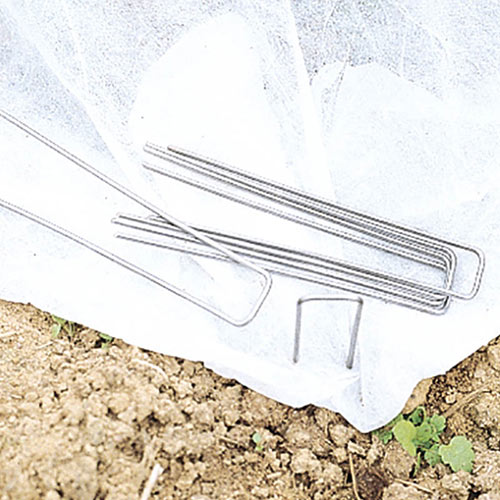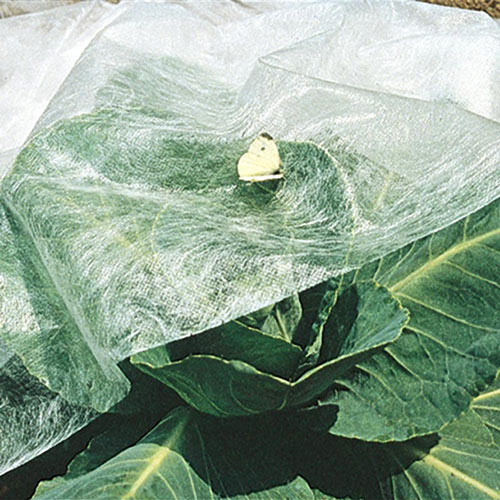'Squash Beetles'? Or Squash Bugs?
-
Helpful Products from Gardens Alive!
-
 Nongalvanized Garden Fabric Pins
Nongalvanized Garden Fabric Pins -
 Super-Lite Insect Barrier - Lightweight Row Cover
Super-Lite Insect Barrier - Lightweight Row Cover
Q. Abbey writes "I'm originally from Northeastern PA (Brodheadsville area) but moved to middle Tennessee a few years ago. My garden was doing GREAT until last year, when squash beetles killed all my zucchini. I pulled out the plants and tried to get rid of the beetles, but I'm wondering if I should dig up and replace my soil this year. What do you suggest?"
A. First, let's do an ID check. There is no insect whose common name is "squash beetle". Adult squash bugs look like long stink bugs. They're around half-an-inch long, brownish-black, elongated and covered with fine hairs. If Abbey's creatures are less elongated and more shield shaped, she may have stinkbugs instead. (They look remarkably alike and both pests are known to attack squash.)
But if the pest doesn't look anything like a stink bug, she might mean cucumber beetles, which come in two varieties: Striped and spotted.
Striped cucumber beetles are a quarter-inch long and yellow with black stripes down their backs. They mostly feed on cukes, but occasionally make mischief on melons and squash. The adults overwinter under plant debris, emerge in Spring, feed on your veggies, mate, and then the females lay tiny yellow/orange eggs at the base of the plants. Around mid-June, the eggs hatch and the larvae dig down and nibble away at the roots of those plants for about six weeks. If you don't locate and squish the eggs (use a mirror taped to the end of a hoe to find them without bending), they can be controlled by beneficial nematodes. Water these microscopic good-guy predators into the soil at the base of the plants early on a July evening and the larvae should soon be devoured.
Spotted cucumber beetles are about the same size but have black spots instead of stripes, are more of a greenish yellow, and lay their eggs earlier in the season. The underground larvae feed and pupate much faster, often leading to multiple generations in a typical year (and making the timing of nematode applications more critical). These beetles also pestiferize a much wider range of plants, including corn; in which case their underground pest self is known as the corn rootworm.
Control measures are the same for both kinds of beetles. Promptly remove and destroy any infested plants (including corn stalks) at the end of the season to reduce the following year's numbers. In Spring, position new plants as far away as possible from the previous year's problem areas.
Squash bugs attack plants like winter squash, zucchini and pumpkins; sometimes cucumbers and melons. These bugs are nasty bad actors that can infect the plants with a virus. Once they start feeding aggressively, the leaves droop, blacken, and fall off. The plant itself often dies; and even if it does survive, rarely produces any more fruit.
These pests also overwinter in the adult stage under mulch and other debris. So one tactic is to remove all the mulch in your garden about a month after you shut things down. Burn or hot-compost it and replace it with a cover crop or a nice fresh mulch of shredded leaves, which should be in abundance at that time of year. Or hold off on the new mulch, place boards on the ground near where infested plants were growing, check them every morning for adults looking for a place to spend the winter and destroy them. (The adults; not the boards.)
The following season, be sure not to plant in the same spots as squash grew the previous year! Remove any protective winter mulch and don't replace it, as it might harbor the pests. Instead spread an inch of rich, finished compost on top of the soil to keep weeds down. It will also feed the plants perfectly.
Numerous studies have shown spun polyester row covers to be the single most effective squash bug tactic. Make sure those covers are tight to the ground and check them frequently. You'll have to remove the covers when the first female flowers open, but that's fine; you're off to a great start.
As soon as you remove your row covers, place boards loosely on the soil alongside your plants. The adults will hide under these boards at night, much like slugs. Go out early in the morning and scrape any squash bugs (and/or slugs) off the bottoms of the boards into a bucket with some soapy water in the bottom.
And/or dust diatomaceous earth (a prehistoric, mined natural product) around the base of your plants. Incredibly sharp on a microscopic level, it will dehydrate and desiccate any squash bugs (and slugs) that try and cross over the white powder.
Hand pick and destroy any adults you see, especially early in the season. You'll greatly minimize problems if you prevent egg-laying by those codgers from last year. Any eggs you miss will hatch into nymphs, the wingless, immature stage of the squash bug. They start out a pale green, darken as they get older and look a little like smaller, doughy versions of the adults. Hand-pick or vacuum up these evil children. Or spray them with insecticidal soap, a light summer spray horticultural oil or a spinosad product. Call them vile names and insult their ancestors.
And finally, plant things like alyssum, calendula, daises, dill, fennel and mustard greens near your squash and cucumbers. Their small, pollen-and nectar-rich flowers will attract the Tachnid fly, an especially beneficial insect that preys on squash bugs.
A. First, let's do an ID check. There is no insect whose common name is "squash beetle". Adult squash bugs look like long stink bugs. They're around half-an-inch long, brownish-black, elongated and covered with fine hairs. If Abbey's creatures are less elongated and more shield shaped, she may have stinkbugs instead. (They look remarkably alike and both pests are known to attack squash.)
But if the pest doesn't look anything like a stink bug, she might mean cucumber beetles, which come in two varieties: Striped and spotted.
Striped cucumber beetles are a quarter-inch long and yellow with black stripes down their backs. They mostly feed on cukes, but occasionally make mischief on melons and squash. The adults overwinter under plant debris, emerge in Spring, feed on your veggies, mate, and then the females lay tiny yellow/orange eggs at the base of the plants. Around mid-June, the eggs hatch and the larvae dig down and nibble away at the roots of those plants for about six weeks. If you don't locate and squish the eggs (use a mirror taped to the end of a hoe to find them without bending), they can be controlled by beneficial nematodes. Water these microscopic good-guy predators into the soil at the base of the plants early on a July evening and the larvae should soon be devoured.
Spotted cucumber beetles are about the same size but have black spots instead of stripes, are more of a greenish yellow, and lay their eggs earlier in the season. The underground larvae feed and pupate much faster, often leading to multiple generations in a typical year (and making the timing of nematode applications more critical). These beetles also pestiferize a much wider range of plants, including corn; in which case their underground pest self is known as the corn rootworm.
Control measures are the same for both kinds of beetles. Promptly remove and destroy any infested plants (including corn stalks) at the end of the season to reduce the following year's numbers. In Spring, position new plants as far away as possible from the previous year's problem areas.
Squash bugs attack plants like winter squash, zucchini and pumpkins; sometimes cucumbers and melons. These bugs are nasty bad actors that can infect the plants with a virus. Once they start feeding aggressively, the leaves droop, blacken, and fall off. The plant itself often dies; and even if it does survive, rarely produces any more fruit.
These pests also overwinter in the adult stage under mulch and other debris. So one tactic is to remove all the mulch in your garden about a month after you shut things down. Burn or hot-compost it and replace it with a cover crop or a nice fresh mulch of shredded leaves, which should be in abundance at that time of year. Or hold off on the new mulch, place boards on the ground near where infested plants were growing, check them every morning for adults looking for a place to spend the winter and destroy them. (The adults; not the boards.)
The following season, be sure not to plant in the same spots as squash grew the previous year! Remove any protective winter mulch and don't replace it, as it might harbor the pests. Instead spread an inch of rich, finished compost on top of the soil to keep weeds down. It will also feed the plants perfectly.
Numerous studies have shown spun polyester row covers to be the single most effective squash bug tactic. Make sure those covers are tight to the ground and check them frequently. You'll have to remove the covers when the first female flowers open, but that's fine; you're off to a great start.
As soon as you remove your row covers, place boards loosely on the soil alongside your plants. The adults will hide under these boards at night, much like slugs. Go out early in the morning and scrape any squash bugs (and/or slugs) off the bottoms of the boards into a bucket with some soapy water in the bottom.
And/or dust diatomaceous earth (a prehistoric, mined natural product) around the base of your plants. Incredibly sharp on a microscopic level, it will dehydrate and desiccate any squash bugs (and slugs) that try and cross over the white powder.
Hand pick and destroy any adults you see, especially early in the season. You'll greatly minimize problems if you prevent egg-laying by those codgers from last year. Any eggs you miss will hatch into nymphs, the wingless, immature stage of the squash bug. They start out a pale green, darken as they get older and look a little like smaller, doughy versions of the adults. Hand-pick or vacuum up these evil children. Or spray them with insecticidal soap, a light summer spray horticultural oil or a spinosad product. Call them vile names and insult their ancestors.
And finally, plant things like alyssum, calendula, daises, dill, fennel and mustard greens near your squash and cucumbers. Their small, pollen-and nectar-rich flowers will attract the Tachnid fly, an especially beneficial insect that preys on squash bugs.
-
Helpful Products from Gardens Alive!
-
 Nongalvanized Garden Fabric Pins
Nongalvanized Garden Fabric Pins -
 Super-Lite Insect Barrier - Lightweight Row Cover
Super-Lite Insect Barrier - Lightweight Row Cover







 Gardens Alive! & Supplies
Gardens Alive! & Supplies




